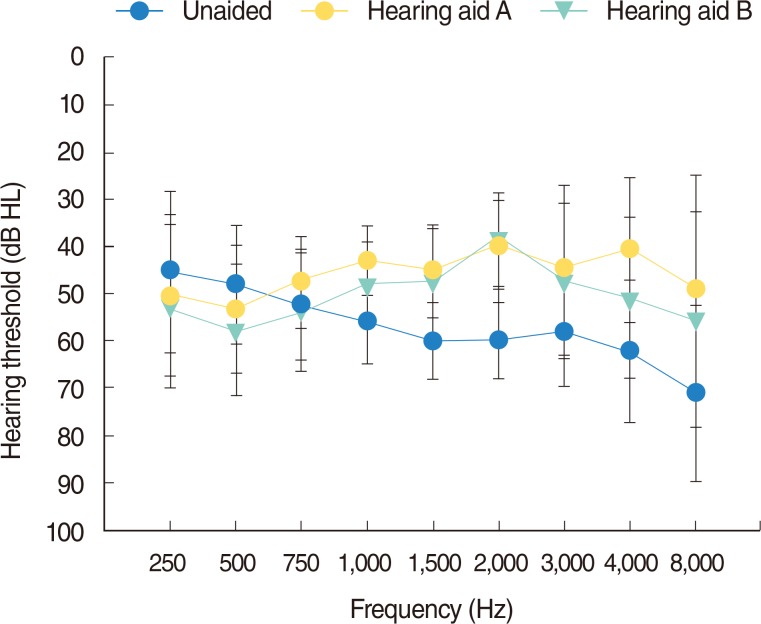1. Ricketts TA. Directional hearing aids: then and now. J Rehabil Res Dev. 2005; Jul-Aug. 42(4 Suppl 2):133–144. PMID:
16470469.

2. Bentler RA. Effectiveness of directional microphones and noise reduction schemes in hearing aids: a systematic review of the evidence. J Am Acad Audiol. 2005; Jul-Aug. 16(7):473–484. PMID:
16295234.

3. Ricketts TA. Directional hearing AIDS. Trends Amplif. 2001; 12. 5(4):139–176. PMID:
25425906.

4. Klemp EJ, Dhar S. Speech perception in noise using directional microphones in open-canal hearing aids. J Am Acad Audiol. 2008; Jul-Aug. 19(7):571–578. PMID:
19248734.

5. Valente M, Mispagel KM, Tchorz J, Fabry D. Effect of type of noise and loudspeaker array on the performance of omnidirectional and directional microphones. J Am Acad Audiol. 2006; 6. 17(6):398–412. PMID:
16866004.

6. Ricketts TA, Hornsby BW. Directional hearing aid benefit in listeners with severe hearing loss. Int J Audiol. 2006; 3. 45(3):190–197. PMID:
16579494.

7. Walden BE, Surr RK, Grant KW, Van Summers W, Cord MT, Dyrlund O. Effect of signal-to-noise ratio on directional microphone benefit and preference. J Am Acad Audiol. 2005; 10. 16(9):662–676. PMID:
16515138.

8. Kuk F, Keenan D, Lau CC, Ludvigsen C. Performance of a fully adaptive directional microphone to signals presented from various azimuths. J Am Acad Audiol. 2005; 6. 16(6):333–347. PMID:
16178405.

9. Cord MT, Surr RK, Walden BE, Dyrlund O. Relationship between laboratory measures of directional advantage and everyday success with directional microphone hearing aids. J Am Acad Audiol. 2004; 5. 15(5):353–364. PMID:
15506497.

10. Wu YH, Bentler RA. Impact of visual cues on directional benefit and preference. Part II. field tests. Ear Hear. 2010; 2. 31(1):35–46. PMID:
19773657.
11. Gnewikow D, Ricketts T, Bratt GW, Mutchler LC. Real-world benefit from directional microphone hearing aids. J Rehabil Res Dev. 2009; 46(5):603–618. PMID:
19882494.

12. Festen JM, Plomp R. Effects of fluctuating noise and interfering speech on the speech-reception threshold for impaired and normal hearing. J Acoust Soc Am. 1990; 10. 88(4):1725–1736. PMID:
2262629.

13. Palmer C, Bentler R, Mueller HG. Evaluation of a second-order directional microphone hearing aid: II. Self-report outcomes. J Am Acad Audiol. 2006; 3. 17(3):190–201. PMID:
16646279.

14. Keidser G, Dillon H, Convery E, Mejia J. Factors influencing individual variation in perceptual directional microphone benefit. J Am Acad Audiol. 2013; Nov-Dec. 24(10):955–968. PMID:
24384081.

15. Wu YH, Bentler RA. Impact of visual cues on directional benefit and preference. Part I. laboratory tests. Ear Hear. 2010; 2. 31(1):22–34. PMID:
19864954.
16. Wu YH. Effect of age on directional microphone hearing aid benefit and preference. J Am Acad Audiol. 2010; 2. 21(2):78–89. PMID:
20166310.

17. Ricketts T, Mueller HG. Predicting directional hearing aid benefit for individual listeners. J Am Acad Audiol. 2000; Nov-Dec. 11(10):561–569. PMID:
11198073.
18. Keidser G, Dillon H, Carter L, O'Brien A. NAL-NL2 empirical adjustments. Trends Amplif. 2012; 12. 16(4):211–223. PMID:
23203416.

19. Jang HS, Lee JH, Lim DH, Lee KW, Jeon AR, Jung EJ. Development of Korean standard sentence lists for sentence recognition tests. Audiology. 2008; 10. 4(2):161–177.

20. Moon SK, Hee Kim S, Mun HA, Jung HK, Lee JH, Choung YH, et al. The Korean hearing in noise test. Int J Audiol. 2008; 6. 47(6):375–376. PMID:
18569115.

21. Nilsson M, Soli SD, Sullivan JA. Development of the Hearing in Noise Test for the measurement of speech reception thresholds in quiet and in noise. J Acoust Soc Am. 1994; 2. 95(2):1085–1099. PMID:
8132902.

22. Ricketts TA. How fitting, patient, and environmental factors affect directional benefit. Hear J. 2003; 11. 56(11):31–39.

23. Brons I, Houben R, Dreschler WA. Effects of noise reduction on speech intelligibility, perceived listening effort, and personal preference in hearing-impaired listeners. Trends Hear. 2014; 10. 18:pii: 2331216514553924.

24. Alcantara JL, Moore BC, Kuhnel V, Launer S. Evaluation of the noise reduction system in a commercial digital hearing aid. Int J Audiol. 2003; 1. 42(1):34–42. PMID:
12564514.
25. Nordrum S, Erler S, Garstecki D, Dhar S. Comparison of performance on the hearing in noise test using directional microphones and digital noise reduction algorithms. Am J Audiol. 2006; 6. 15(1):81–91. PMID:
16803795.

26. Chung K. Challenges and recent developments in hearing aids. Part I. Speech understanding in noise, microphone technologies and noise reduction algorithms. Trends Amplif. 2004; 8(3):83–124. PMID:
15678225.

27. Ricketts T. The impact of head angle on monaural and binaural performance with directional and omnidirectional hearing aids. Ear Hear. 2000; 8. 21(4):318–328. PMID:
10981608.

28. Wu YH, Bentler RA. A method to measure hearing aid directivity index and polar pattern in small and reverberant enclosures. Int J Audiol. 2011; 6. 50(6):405–416. PMID:
21309640.

29. Cox RM, Alexander GC, Taylor IM, Gray GA. Benefit acclimatization in elderly hearing aid users. J Am Acad Audiol. 1996; 12. 7(6):428–441. PMID:
8972444.
30. Dawes P, Munro KJ, Kalluri S, Edwards B. Acclimatization to hearing aids. Ear Hear. 2014; Mar-Apr. 35(2):203–212. PMID:
24351612.








 PDF
PDF Citation
Citation Print
Print


 XML Download
XML Download